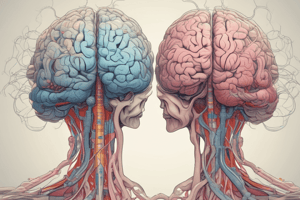Podcast
Questions and Answers
Which part of the human brain separates the frontal lobe from the parietal lobe?
Which part of the human brain separates the frontal lobe from the parietal lobe?
- Lateral fissure
- Central fissure (correct)
- Transverse fissure
- Cerebellar fissure
What is one of the main functions of cerebrospinal fluid?
What is one of the main functions of cerebrospinal fluid?
- Provides energy to neurons
- Transmits neural signals
- Acts as a shock absorber (correct)
- Increases brain temperature
What is the primary role of the choroid plexus in the brain?
What is the primary role of the choroid plexus in the brain?
- Filters toxins from neural pathways
- Transports blood to the brain
- Regulates electrical impulses in neurons
- Produces cerebrospinal fluid (correct)
What imaging technique uses x-rays to create detailed images of brain structure?
What imaging technique uses x-rays to create detailed images of brain structure?
In what order does cerebrospinal fluid flow through the ventricular system?
In what order does cerebrospinal fluid flow through the ventricular system?
What cortex does each lobe contain and what are their functions?
What cortex does each lobe contain and what are their functions?
What are the functions of cerebrospinal fluid?
What are the functions of cerebrospinal fluid?
Where are the ventricles located in the brain?
Where are the ventricles located in the brain?
What is choroid plexus?
What is choroid plexus?
What is the order that cerebrospinal fluid flows through the ventricles?
What is the order that cerebrospinal fluid flows through the ventricles?
In the human brain, which fissure divides the frontal from parietal lobe?
In the human brain, which fissure divides the frontal from parietal lobe?
What are the basic structures of the neuron?
What are the basic structures of the neuron?
What imaging technique uses x-rays to create detailed images of brain structure?
What imaging technique uses x-rays to create detailed images of brain structure?
Which imaging technique uses magnetic fields and radio waves to create images?
Which imaging technique uses magnetic fields and radio waves to create images?
Study Notes
Chapter 3: Brain Lobes and Ventricular System
- Frontal lobe: Contains the motor cortex (voluntary movement), prefrontal cortex (higher-level cognitive functions), Broca's area (speech production).
- Parietal lobe: Contains the somatosensory cortex (touch, temperature, pain), spatial processing areas.
- Temporal lobe: Contains the auditory cortex (hearing), Wernicke's area (speech comprehension), hippocampus (memory), amygdala (emotion).
- Occipital lobe: Contains the visual cortex (vision).
- Cerebrospinal fluid (CSF) functions: Cushions the brain, removes waste products, helps regulate intracranial pressure.
- Ventricular system: A network of cavities within the brain filled with CSF. Ventricles are located in the cerebral hemispheres and brainstem.
- Choroid plexus: A network of capillaries and ependymal cells that produce CSF.
- CSF flow order: Lateral ventricles → third ventricle → cerebral aqueduct → fourth ventricle → subarachnoid space.
- The central sulcus divides the frontal lobe from the parietal lobe.
Chapter 2: Neuron Structure
- Basic neuron structures: Soma (cell body), dendrites (receive signals), axon (transmits signals), axon terminals (release neurotransmitters).
Chapter 4, 5, 19: Neuroimaging
- Computed tomography (CT): Uses X-rays to produce detailed images of brain structure.
- Magnetic resonance imaging (MRI): Uses magnetic fields and radio waves to create brain images.
Chapter 3: Brain Lobes and Ventricular System
-
Frontal lobe cortex: Higher-level cognitive functions, voluntary movement.
-
Parietal lobe cortex: Processing sensory information (touch, temperature, pain, spatial awareness).
-
Temporal lobe cortex: Auditory processing, memory, language comprehension.
-
Occipital lobe cortex: Visual processing.
-
Cerebrospinal fluid (CSF) functions: Cushioning the brain, removing waste products, maintaining stable brain environment.
-
Ventricular system: Network of cavities within the brain containing CSF. Ventricles are located within the brain's hemispheres and brainstem.
-
Choroid plexus: Specialized tissue within ventricles that produces CSF.
-
CSF flow order through ventricles: Lateral ventricles → Interventricular foramina → Third ventricle → Cerebral aqueduct → Fourth ventricle → Subarachnoid space.
-
Central sulcus: Separates frontal and parietal lobes.
Chapter 2: Neuron Structure
- Neuron basic structures: Soma (cell body), dendrites (receive signals), axon (transmits signals), axon terminals (release neurotransmitters).
Chapter 4, 5, 19: Neuroimaging Techniques
- Computed tomography (CT): X-ray-based imaging of brain structure.
- Magnetic resonance imaging (MRI): Magnetic fields and radio waves used to create detailed brain images.
Studying That Suits You
Use AI to generate personalized quizzes and flashcards to suit your learning preferences.
Description
This quiz covers the functions and structures of the brain's lobes, including the frontal, parietal, temporal, and occipital lobes. It also explores the ventricular system and the role of cerebrospinal fluid in brain protection and waste removal. Test your understanding of how these components interact within the central nervous system.




